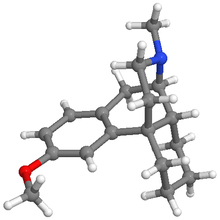Levomethorphan
 |
|
 |
|
| Clinical data | |
|---|---|
| ATC code | None |
| Legal status | |
| Legal status |
|
| Pharmacokinetic data | |
| Biological half-life | 3-6 hours |
| Identifiers | |
|
|
| CAS Number |
125-70-2 |
| PubChem (CID) | 5362449 |
| ChemSpider |
4642423 |
| UNII |
7ZZ22K9QE6 |
| ChEMBL |
CHEMBL1908323 |
| Chemical and physical data | |
| Formula | C18H25NO |
| Molar mass | 271.397 g/mol |
| 3D model (Jmol) | Interactive image |
|
|
|
|
|
|
|
Levomethorphan (INN, BAN) is an opioid analgesic of the morphinan family that has never been marketed. It is the L-stereoisomer of racemethorphan (methorphan). The effects of the two isomers of the racemethorphan are quite different, with dextromethorphan (DXM) contrarily being an antitussive at low doses and a dissociative hallucinogen at much higher doses. It is about five times stronger than morphine.
Levomethorphan is a prodrug to levorphanol, analogously to DXM acting as a prodrug to dextrorphan or codeine behaving as a prodrug to morphine. As such, levomethorphan has similar effects to levorphanol but is less potent as it must be demethylated to the active form by liver enzymes before being able to produce its effects. As a prodrug of levorphanol, levomethorphan functions as a potent agonist of all three of the opioid receptors, μ, κ (κ1 and κ3 but notably not κ2), and δ, as an NMDA receptor antagonist, and as a serotonin-norepinephrine reuptake inhibitor. Via activation of the KOR, levomethorphan can produce dysphoria and psychotomimetic effects such as dissociation and hallucinations.
...
Wikipedia
